Ancient Warfare: The Military Strategies of Old Societies
Throughout history, warfare has been a constant factor in the development and evolution of societies. Ancient warfare, in particular, was characterized by a wide array of military strategies and tactics that were employed by various civilizations. This article delves into the military strategies of old societies, exploring the different approaches they took to warfare and how these strategies shaped the course of history.
Introduction to Ancient Warfare
Ancient warfare refers to the organized, armed conflict that took place in the ancient world, from the earliest recorded history to the fall of the Western Roman Empire in the 5th century AD. The strategies and tactics employed during this period were influenced by a variety of factors, including technological advancements, geographical considerations, and cultural beliefs.
Advertisement
Key Military Strategies
1. Phalanx Formation
The phalanx formation was a popular military strategy used by ancient Greek and Macedonian armies. It involved arranging soldiers in a compact, rectangular formation with overlapping shields and long spears. This allowed the soldiers to protect one another and present a formidable front to the enemy.
2. Cavalry Charges
Cavalry charges were a common tactic used by many ancient societies, including the Persians, Romans, and Mongols. This strategy involved using the speed and power of mounted warriors to break through enemy lines and create chaos and fear among the opposition.
3. Siege Warfare
Siege warfare was a military strategy that focused on capturing enemy strongholds and cities by isolating and cutting off supplies. Ancient civilizations like the Romans were particularly adept at siege warfare, employing various techniques such as constructing siege towers, battering rams, and catapults to breach city walls.
4. Naval Warfare
Naval warfare was an important aspect of ancient warfare, particularly for civilizations that relied on maritime trade and exploration. The Greeks and Romans developed sophisticated naval tactics, including the use of triremes and quinqueremes, which were warships designed for speed and maneuverability.
5. Psychological Warfare
Psychological warfare was a strategy used to demoralize and weaken an enemy before engaging in physical combat. This could involve spreading rumors, displaying captured enemy soldiers, or even using animals to intimidate the opposition. The use of war elephants by the Carthaginians during the Punic Wars is a prime example of this tactic.

6. Guerrilla Warfare
Guerrilla warfare is a military strategy that involves using small, mobile forces to launch surprise attacks on a larger, more organized enemy. This tactic was employed by various ancient societies, including the Parthians, who were known for their skill in horse archery and hit-and-run tactics.
Factors Influencing Military Strategies
1. Technology
The technological advancements of a civilization played a significant role in shaping its military strategies. For example, the development of the composite bow by the Mongols allowed them to become highly effective archers, while the Romans' mastery of engineering enabled them to build advanced siege equipment and fortifications.
2. Geography
Geography was another important factor in determining military strategies. Armies that were accustomed to fighting in open, flat terrain, like the Persians, might struggle against opponents who were skilled in mountain or forest warfare, such as the Greeks.
3. Culture
Cultural beliefs and values also influenced the military strategies of ancient societies. For example, the Spartans placed a high value on discipline and physical fitness, which led to their development of the phalanx formation and their reputation as fierce warriors.
Conclusion
Ancient warfare was a complex and multifaceted aspect of human history, with a wide range of military strategies employed by different civilizations. Understanding these strategies and the factors that influenced them can provide valuable insights into the development of human societies and the enduring nature of conflict.
Comments